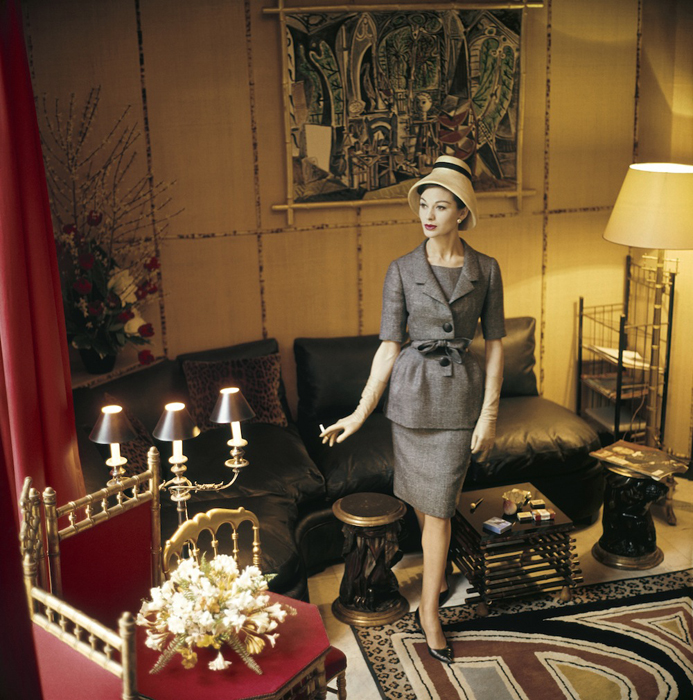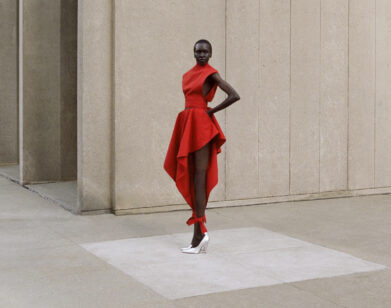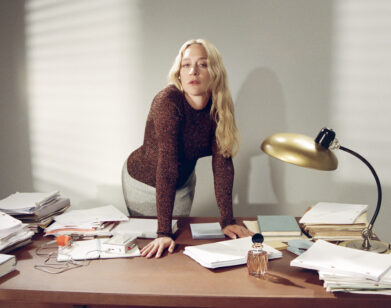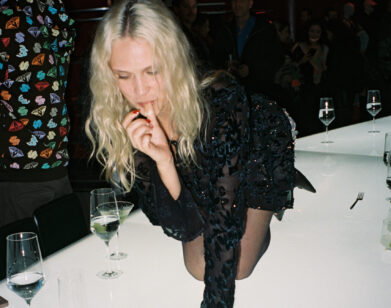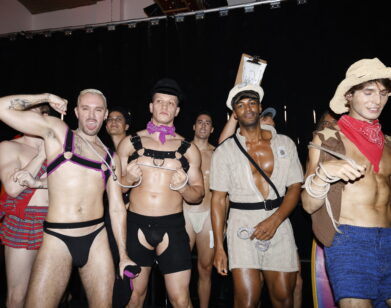Mark Shaw’s Golden Age of Dior Couture
Haute couture of the 1950s and ’60s often evokes images of stiffly posed bodies in lavish gowns and models devoid of natural life. Photographer Mark Shaw saw things differently. While he is remembered for intimate portraits of the Kennedy family, recently discovered photographs that he shot at the House of Dior from 1952-62 will reshape his portfolio. As an American photographer in Paris during couture’s Golden Age, he provided a unique point of view—one that was full of life and color.
Bringing with him the nature of photo essays in American culture, the Life magazine photographer captured energy and movement within the house of Dior; he countered post-WWII European modernism with his American realism. And merely one year ago, gallerist Andrew Wilder, who has the rights to sell Shaw’s photographs, barely knew the extent of the material he had available.
“At the Mark Shaw archive, there were boxes of material labeled ‘Dior’ that had never been looked at because it was all negative strips with no contact sheets,” he explains. Before sorting through the material, he proposed a book deal to Dior’s execs in Paris. They agreed.
“Then the archive began the process of scanning this material that was in manila envelopes,” Wilder continues. “What they discovered was this enormous backstory… very important documentation of Paris Golden Age couture.”
This week, the book Dior Glamour: 1952 to 1962 comes out via Rizzoli, with some of Mark Shaw’s photographs available to purchase through 1stDibs. We spoke with Wilder about his discoveries and Shaw’s photographic legacy.
EMILY MCDERMOTT: I’ve been looking through the Dior book and the new photos you found. They’re absolutely stunning. I would love to talk a little about the discovery.
WILDER: The story with Mark Shaw’s archive is that, when Mark Shaw died in 1969—and he died very suddenly in the height of his career—all of his work was put into storage in Manhattan and it remained there for more than 30 years. Then Mark Shaw’s heirs inherited all of that work. Bit by bit, they have been working to reveal the best of what he captured in his lifetime. The first project was the Kennedys work, and we started working on the fashion work about six years ago, but this Dior material that’s in the book was found this past year.
Two years ago, Dior purchased 10 Shaw prints, which captured important moments in Dior history. That’s how we began a relationship with Dior. We met with the international head of communications and he was very enthusiastic about doing a book project. He asked me to send everything that we could find. What they discovered was this enormous coverage for Life magazine throughout the ’50s when Dior was five or six years into his business.
MCDERMOTT: Can you talk about the 10 original prints they wanted?
WILDER: These were images that were capturing couture and interior design. We weren’t clear on where they had been shot because we had so little information. As it turns out, a handful were photographed inside the apartment of Suzanne Lulling, who was the directrice of Dior. It was very important in terms of where Dior did their business and held early gala parties. The fact that we had photographs inside of that apartment and that they were in color completely blew Dior away.
MCDERMOTT: Did you know Shaw before he died?
WILDER: No, Shaw died in ’69. I was a kid. Shaw had been one of the five top photographers in New York in the ’50s and he had the Kennedy’s book within his life, which was a bestseller, but he died and it was all put into archives. He was forgotten about.
MCDERMOTT: So what reactions have you seen since you’ve been reintroducing his work?
WILDER: People are amazed. The fact that he was capturing this ’50s period in color for Life magazine is very unusual. He was a pioneer in color and had a very natural touch in the way he posed his subjects. The whole sense of life within his photography of this period amazes people because they’re used to seeing it in a much more stiff way.
MCDERMOTT: What are some of the biggest moments you remember while working on his archive?
WILDER: I can remember the first day that I was working with the Mark Shaw Photographic Archive and when they agreed to start showing me some of the fashion material. We were at the archives in Vermont looking at the work, David Shaw—who is Mark’s son—brought out a slide carousel of the Christian Dior couture show in 1964 in color. I had this incredible sense of privilege being able to see those images and get a sense of what it was really like in that time. That era for us, how we perceive it, is so specific. When you look at those photographs and see the women in the audience who are so doughty and unexpected—we marvel in that.
When were revealing the material for Dior, we were getting into situations where it seemed like Mark Shaw was using four or five cameras and going from couture show to couture show within the same week. We’d have material that looked like it was from Dior; then we’d have material on the same roll that looked like it was from Balmain. It became my job to pick out specific elements in the different houses—like the banister or chairs that the attendees were sitting on—so that I could sort out what was Dior, what was Balmain. That’s the sort of thing you don’t expect to ever happen in your lifetime.
MCDERMOTT: I can imagine trying to sort through all of those details must have been incredible.
WILDER: Fascinating—challenging, but truly fascinating. There was not a moment throughout this project where I wasn’t being a sleuth or trying to ascertain which shots could be made into prints. There wasn’t a moment that wasn’t completely thrilling and fascinating.
MCDERMOTT: Do you think that you’ll try to move onto other fashion houses Shaw shot?
WILDER: We’ve already begun doing a little bit of business with Schiaparelli, for example, but Life was completely obsessed with Christian Dior in this period, so we have the most significant amount and best material of the House of Dior. But we have portraits of Coco Chanel. We have portraits of Yves Saint Laurent. Those were discovered by accident when we were sourcing Dior material.
MCDERMOTT: How were they discovered by accident?
WILDER: Because they literally slipped out of a folder. This happens constantly with Mark Shaw. It’s incredible. The amount of work that he did in 10 years is unbelievable.
MCDERMOTT: He was only photographing for 10 years?
WILDER: He was photographing more than that, but after ’52-’62, he was working more on television. The Yves Saint Laurent shots that no one has seen was a roll of film that fell out of a Dior file. It’s Yves Saint Laurent at his first salon show, and one of the primary attendees there is Lee Radziwill.
MCDERMOTT: Oh, wow. What’s one of your favorite images that you’ve stumbled upon in this way?
WILDER: The color shots of Christian Dior adjusting that incredible model Victorie in the red dress and he’s adjusting the red jewels. Those were stumbled upon two years ago. They have since used that photograph to illustrate Dior stories all over the world, but that’s the kind of stuff that shakes out of files at Shaw’s archive.
MCDERMOTT: What are some of the most notable things that you have learned from working with Shaw’s archives and on the book?
WILDER: Understanding what a great photograph is. If he had a setup of an interior shot for example, there might be 150 to 200 shots that we would choose from. I didn’t have any background in the photo gallery world, and we’ve learned to understand what makes a great photograph, what about Mark Shaw’s compositions is special… you’re going to ask me what it is, right? [laughs]
MCDERMOTT: [laughs] Yeah—so for you, what makes a great photograph?
WILDER: What I think Mark Shaw is brilliant at is the ability to capture in action and in focus. That’s why his photography is often so remarkable and unusual, because not only do you have the incredible fashion happening—and a beautiful model—but you also have some scene going on in the background that has significance. It can be a beautiful streetscape taken 50 years ago that has great detail about what life was like on the streets of Paris, or it can be an incredible interior. That’s what brings it beyond your average fashion photograph; there’s context around the subject.
Dior from day one working with me has had this one quote that they always use: [in faux French accent] “The work of Mark Shaw is full of life.” And it is. The photography of Dior that Dior had from their in-house photographers of the period is typical black-and-white fashion photography of the period. It’s not well framed. It’s not revealing much. It’s very mannered, capturing high society in a way that’s not inviting. It’s not an American kind of approach. In the 1950s, Americans were much more informal, more working class.
MCDERMOTT: So do you think it was him being an American that allowed him to have this different insight?
WILDER: Oh yes, absolutely. I’ll go back to shooting for Life and capturing lifestyle: this was a uniquely American way of looking at fashion. This is what the French love. It’s so different than what they would have appreciated or captured in the day. This was exclusive and a secretive little thing.
MCDERMOTT: Yeah, a peek into Dior’s secret world that they still maintain today. I find it interesting that Shaw was so interested in fashion and was then given access to the Kennedy family, because Jackie Kennedy is one of the most fashionable First Ladies of all time. Do you think that is more than coincidence?
WILDER: Absolutely. Mark was hired by Life to shoot that first story of John and Jackie. It was a profile of Jackie in 1959 as Kennedy was running for president. She was aware of the fact that [Shaw] was a very good fashion photographer, and what his work was like. He brought his ability to capture subjects beautifully to capturing the Kennedy family. The beach material [of the Kennedys] is the first time a photographer is taking a political family and capturing them as celebrities. That was enormously powerful in establishing the Kennedy-Camelot-ness-politicians being that aware of their images and understanding how the right photographer could present them to the world.
MCDERMOTT: If he were still alive today, whom do you think he would be shooting for?
WILDER: [laughs] Well, there’s no Life magazine anymore. [Life] crossed the board in terms of social classes, so the amount of power that it wielded and the amount of doors that it opened were incredible. I don’t think there’s a fashion magazine that has that kind of power now. So whom would Mark Shaw be shooting for? If I said Vogue, it would be discounting it, because his abilities went beyond just a fashion shot. It went more into the realm of lifestyle. It sounds bogus to say that, but it did. That’s what Life was about. So whom would he be shooting for? He’d be happily retired and living in East Hampton.
DIOR GLAMOUR: 1952 TO 1962 IS OUT NOW. SELECT DIOR PHOTOGRAPHS BY MARK SHAW ARE AVAILABLE TO PURCHASE VIA 1STDIBS.

